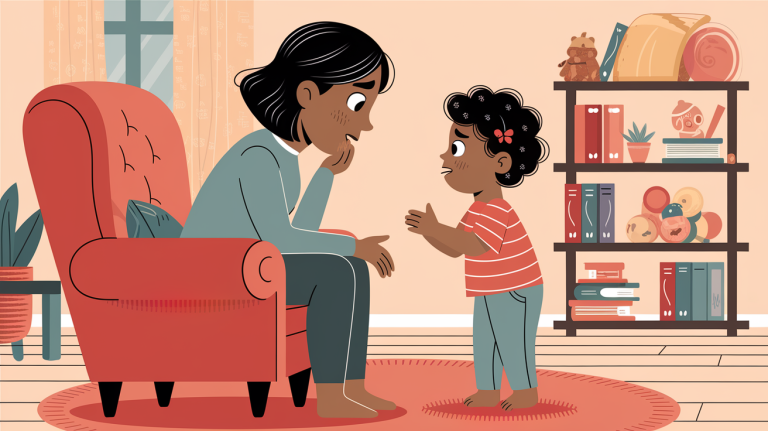Understanding Extinction Bursts in Sleep Training

Sleep training can feel like a rollercoaster for parents, especially when things seem to get worse before they get better.
An extinction burst is a temporary increase in crying or resistance that many children show during sleep training.
This phase happens when a child’s familiar sleep routine changes, and they test if their old comfort methods will return.
Understanding extinction bursts helps parents stay calm and confident during this challenging time. These moments are completely normal and actually signal that the child is learning new sleep skills.
While it can be heartbreaking to hear increased crying, knowing what to expect makes the process easier for the whole family.
What Is an Extinction Burst?
An extinction burst is a sudden spike in crying, fussing, or resistance when a child’s usual sleep routine changes.
Think of it as the child’s way of asking, “Are you sure the old way isn’t coming back?” When parents stop feeding, rocking, or using other sleep aids, children often protest more intensely at first.
This reaction happens because the child has learned that crying or fussing previously brought comfort.
When that comfort doesn’t come as expected, they may cry harder or longer, hoping to get the familiar response. It’s similar to pressing an elevator button repeatedly when it doesn’t arrive quickly enough.
The psychology behind extinction bursts is simple but important to understand. When any habit changes, there’s often an initial period of increased effort to maintain the old pattern.
Why Do Extinction Bursts Occur During Sleep Training?

Sleep training removes the reinforcement children have come to expect from their nighttime routine. If a child is used to being rocked to sleep or fed during night wakings, they’ve learned that crying brings these comforts.
When sleep training begins, parents stop providing these responses, which can initially confuse the child.
Children naturally resist change and prefer familiar routines that make them feel secure. Sleep associations like pacifiers, feeding, or rocking become deeply ingrained habits.
When these supports are removed, children may increase their protests as they adjust to the new expectations. The extinction burst actually shows that the child is learning new sleep habits.
When and How Do Extinction Bursts Happen?

Understanding the timing and patterns of extinction bursts helps parents prepare for this phase and recognize it when it occurs.
Extinction Burst Timelines
While every child is different, there are common timelines and behaviors that families can expect during sleep training.
| Timeline | What Typically Happens | What Parents Notice |
|---|---|---|
| Nights 1-2 | Initial adjustment period with expected crying | Protest crying during bedtime routine changes |
| Nights 3-7 | Peak extinction burst period (most common) | Sudden increase in crying intensity or duration |
| Nights 4-5 | Often, the most challenging nights | Longer protest periods, more frequent wake-ups |
| Week 2 | Less common but possible secondary burst | Brief return of increased resistance after initial progress |
| Ongoing | Gradual improvement with occasional rough nights | Steady progress with minor setbacks during illness or changes |
Note: Not all children experience extinction bursts, and timing can vary significantly based on the child’s temperament, age, and the sleep training method used.
The burst usually appears as a sudden return or increase in crying after families thought they were making good progress.
This can feel particularly discouraging because parents may worry that their approach isn’t working. However, this pattern is actually a normal part of the learning process and often indicates that the child is adapting to the new routine.
How Long Do Extinction Bursts Last?
Extinction bursts typically last from one night to about a week, though duration varies significantly between children.
Some children move through this phase quickly, while others take longer to adjust. The key is maintaining consistency regardless of how long the phase lasts.
Several factors influence how long extinction bursts continue. A child’s temperament plays a significant role, with some children being naturally more adaptable than others.
The sleep training method used and how consistently parents apply it also affect the duration. Parental consistency is perhaps the most important factor in determining length.
When parents stick to their plan despite increased crying, children typically move through the burst phase more quickly. Inconsistent responses can prolong the process and create confusion.
Are Extinction Bursts Normal? (And What Do They Mean?)
Yes, extinction bursts are very common and indicate that a child is adapting to new routines. Rather than being a sign of failure, they often show that the sleep training is working.
The child is learning that their old sleep associations are no longer available, which is exactly what needs to happen.
These bursts are frequently a sign of progress rather than a step backward. When children increase their protests, it often means they’re realizing the old routine isn’t returning.
This understanding is a crucial part of developing new, independent sleep skills. The emotional impact on both parents and children can be intense during this phase. Parents may feel guilty or worried about their child’s increased crying.
Children may feel confused about the changes. Understanding that these feelings are normal helps families stay committed to the process.
Managing Extinction Bursts: What Should Parents Do?

When extinction bursts occur, parents often feel unsure about how to respond to their child’s increased crying and resistance. The key is understanding that this phase requires patience, consistency, and trust in the sleep training process.
1. Stay Consistent with Your Sleep Training Plan
The most important thing parents can do is stick to their chosen sleep training method, even when crying increases. This means following the same bedtime routine, using the same responses, and maintaining the same expectations each night.
Consistency helps children understand that the new routine is here to stay, not just a temporary change.
2. Avoid Giving In to Increased Protests
Returning to old sleep habits during an extinction burst can actually make the situation worse and extend the adjustment period.
When parents give in to increased crying by rocking, feeding, or using previous comfort methods, they accidentally teach their child that protesting harder works. This can reset the entire sleep training process and create confusion about expectations.
3. Trust the Process and Focus on Long-Term Benefits
Continuing with the sleep training plan during difficult nights teaches children valuable self-soothing skills.
While it can be emotionally challenging to maintain consistency when crying increases, doing so helps children build confidence in their ability to sleep independently. The temporary discomfort leads to lasting improvements in sleep quality for the whole family.
Practical Tips for Handling Extinction Bursts
These practical tips help families navigate this challenging phase while maintaining their sleep training goals.
| Tip | What to Do | Why It Helps |
|---|---|---|
| Maintain Bedtime Routine | Follow the same bedtime steps and timing each night | Creates predictability and security during change |
| Offer Comfort Without Old Habits | Use brief check-ins, soothing voice, or gentle words | Provides reassurance without interfering with sleep learning |
| Practice Self-Care | Take breaks, seek support from partners or sleep consultants | Helps parents stay emotionally strong and consistent |
| Keep a Sleep Log | Track patterns and progress during the extinction burst | Shows improvement over time and validates the process |
| Prepare for Difficult Nights | Have a plan for managing emotions and staying consistent | Reduces decision-making stress during challenging moments |
| Know When to Seek Help | Contact professionals if the bursts last unusually long | Ensures the child’s well-being and provides expert guidance |
Common Misconceptions About Extinction Bursts
Many parents worry that increased crying means sleep training is failing, when actually the opposite is often true.
Extinction bursts frequently indicate that the child is learning and adapting to new expectations. Understanding this helps parents stay committed to their plan.
Another common misconception is that parents need to switch methods when crying increases. However, changing approaches during an extinction burst can confuse children and prolong the adjustment period.
Consistency with the chosen method typically yields better results than switching between different approaches.
Some parents believe that extinction bursts mean their child can’t handle sleep training.
In reality, most children can learn independent sleep skills successfully with patient and consistent guidance. The burst phase is simply part of the natural learning process.
Conclusion
Extinction bursts are a normal, temporary phase that many families experience during sleep training.
While increased crying can feel overwhelming, it often signals that children are successfully learning new sleep skills. This challenging period typically lasts only a few days to a week.
Staying consistent, practicing patience, and showing self-compassion are key to navigating extinction bursts successfully.
Independent sleep leads to better rest for everyone and stronger confidence in children’s ability to self-soothe. The long-term benefits include peaceful nights and well-rested families.
Share your extinction burst experience in the comments below; your story could provide comfort and encouragement to other parents guiding this challenging but temporary phase of sleep training.






